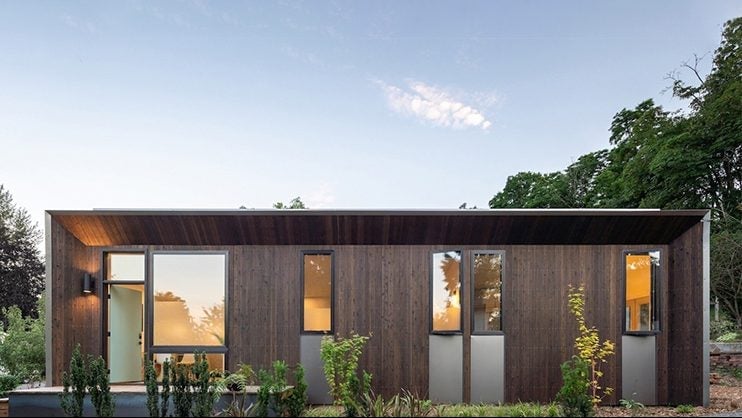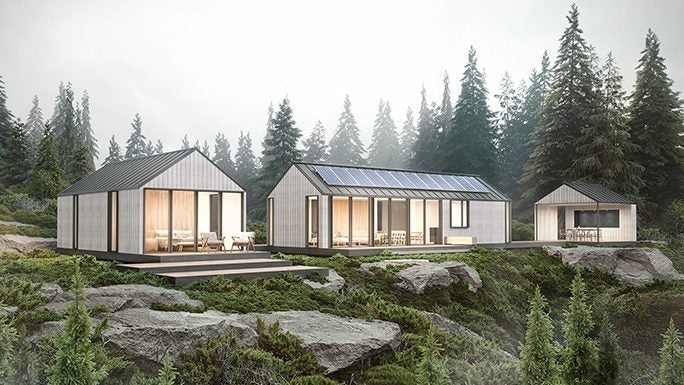Pre-fab homes are coming to a city backyard near you
Not much has changed when building homes in the US. Dozens of workers show up at a dirt lot. Tons of materials are delivered. Crews hammer, pour, and nail them together over weeks and months, according to an architect’s drawings. One more family is housed, albeit often late and over budget, at an average cost of $428,000.


Not much has changed when building homes in the US. Dozens of workers show up at a dirt lot. Tons of materials are delivered. Crews hammer, pour, and nail them together over weeks and months, according to an architect’s drawings. One more family is housed, albeit often late and over budget, at an average cost of $428,000.
That equation isn’t working well in America’s cities. The affordable housing crisis has now spread from densely packed cities like New York to almost every major metropolis. Policy and zoning play a major role. Yet the cost of construction looms over everything.
The cost of building one unit of affordable housing—a unit, not a house—in a city like San Francisco can run as high as $750,000. At that price, the region will never serve the number of people it needs to shelter. We must make cheaper homes, at scale, and fast to ease the cost of living for working- and middle-class residents being squeezed out of cities.
Pre-fab is one solution
In the popular imagination, pre-fabricated housing brings to mind trailer homes or catalog-ordered log cabins. Both suffer from quality, code and aesthetic issues that make them unsuitable for cities.
Seattle-based startup Node sees an urban future for housing built in a factory. Node wants to be the Ikea of the home industry. The modular homes it is making can be flat-packed—the ultra-efficient technique popularized by the Swedish retailer—and then assembled in a matter of days on site. Shingles fasten into place. Walls snap together in metal brackets. No nails or screws are needed for assembly (a revolution for the construction industry). These aren’t sheds. Beautiful woods, expansive windows, and a modernist aesthetic recall modernist homes in Scandinavia.

Node’s technology, still under development, uses standard materials: wood, metal, and insulation. Its secret, says Bec Chapin, co-founder and chief operating officer, is how it’s all manufactured, assembled, and monitored. Software and sensors keep the home environment comfortable and carbon-neutral. Solar panels power the entire home. Specially designed brackets mean the entire home will be able to be put together in a matter of days. “It’s Legos,” says Chapin.
Node has its sights set on backyards: More than two dozen cities are changing zoning to encourage in-law units and backyard cottages. So far, their cottages—homes with two bedrooms and one bath, covering between 400 to 1,000 square feet—have sold well, Chapin said during a presentation at Y Combinator’s Demo Day in San Francisco this week. So far, they’ve booked 11 sales worth $2.7 million, at 50% margins, which is high in the construction industry. Homes sold so far are in the $250,000 range, competitive with conventional custom construction.
Eventually, Node hopes to scale up to offering multi-family apartments up to five-stories high. The company has a way to go. Much of the homes’ plumbing, electrical, and other systems are still off-the-shelf, and manually assembled, so plenty of work has to be done on site. Prices aren’t much lower than conventional construction yet, either. Node plans to integrate all the materials, such as water and electric systems, into factory-made assemblies, which Chapin says will slash on-site labor costs by 90%. That should translate into big price reductions.
America needs density
At best, pre-fab housing and promising technologies like 3D-printing are half measures when it comes to addressing the US housing crisis. What really is needed: more openness to density.
Housing regulations often prevent the construction of new housing where it’s needed most. In many cities if taxpayers spend billions on a subway station or public transit hub, local residents can often block any high-density apartments nearby. Neighborhood preferences can trump regional solutions, meaning younger generations are priced out from cities where they can earn a better living. NIMBY-ism then serves as a massive wealth transfer from the poor and middle class to the relatively rich.
Backyard cottages are popular, in part, because they sidestep these thorny politics. The reason is money. Homeowners in coveted urban neighborhoods tend to be older and have political sway. Adding one more unit to their property puts money into their pocket. Adding a new apartment building around the corner draws out protesters in droves.
Until the US solves its housing imbalance, it will continue to exclude lower- and middle-class Americans from its most prosperous cities. Another rising generation will continue to struggle to secure a financial future.
As it stands now, urban policy in most of the US says let them live in other people’s backyards.